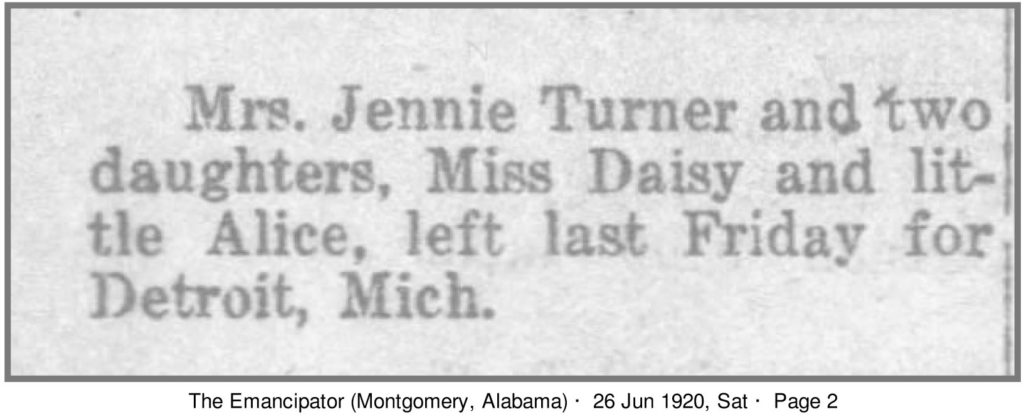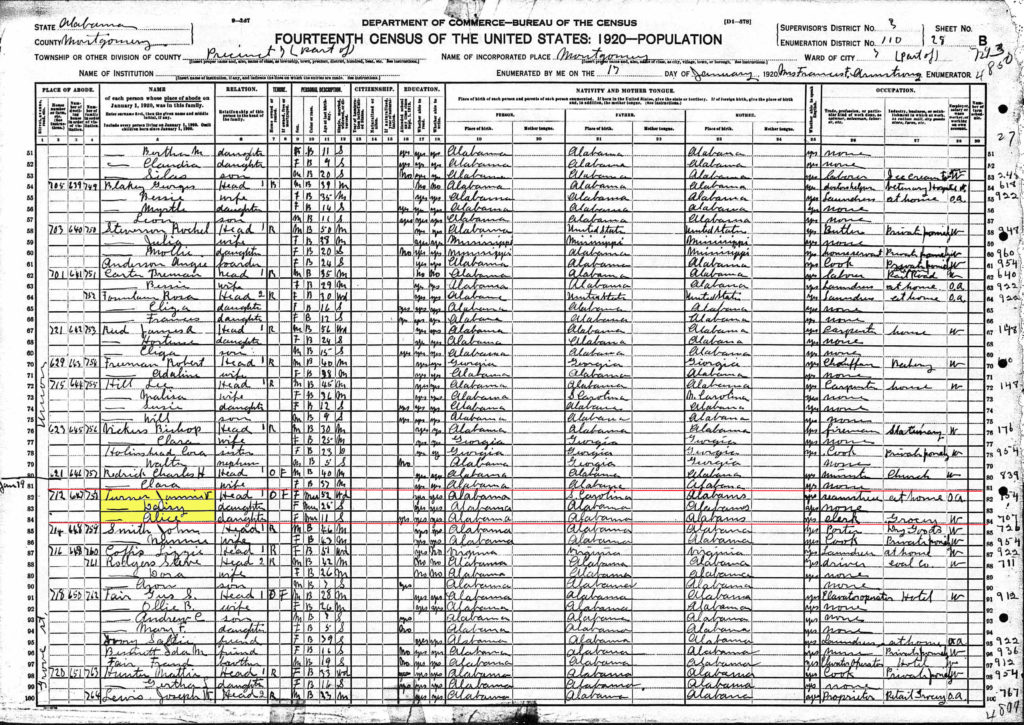
My grandmother Fannie’s mother Jennie Virginia Allen Turner and her two other daughters were still in Montgomery, Alabama when the census was taken on January 19, 1920. My great grandmother Jennie was living in the same house she had lived in during the 1910 census. She owned it free of mortgage. All three were listed as mu(latto) and spoke English.
Jennie was 52 years old. She had been born in Alabama and the census said her father was born in South Carolina, although other records say Georgia. Her mother was born in Alabama.
She worked on her own account as a seamstress from her home. The oldest daughter, Daisy, was 25 and occupation is listed as none, while younger daughter Alice, was 11 and listed as both attending school and working as a clerk in a grocery store. Actually, Daisy was working as a clerk in her uncle Victor Tulanes store. Alice just attended school.
All of their neighbors on the page were listed as B(lack). Thirteen of them rented their houses while three owned their homes. The school age children in these families all attended school, except for one 16 year old who worked as a laundress with her mother.
Some of the married women worked outside of the home and some did not. The single women worked. They held jobs as cooks, laundresses, elevator operators, house servants. With one seamstress and one clerk.
The men worked as porters, carpenters, one doctors keeper, a butler, laborers, a chauffeur, a fireman, a minister, a driver, and a proprietor of a retail store. Thirteen rented and three owned their homes free and clear.

When her grandchildren were born in 1920 and in 1921, Jennie Turner and her daughters visited Fannie in Detroit. In 1922 when Fannie and Mershell were waiting for the birth of their third child, my mother Doris, Jennie, Daisy and Alice moved to Detroit. The two households bought a house together and eventually my great grandmother and her younger daughters bought another house further out on the East side of Detroit.


Yet another interesting chapter in your family history.
With more in the wings!
The notice in The Emancipator that your great-grandmother and her daughters (your great-aunts, right?) were going to visit Detroit sounds very momentous. (Were they part of a small middle/upper-middle class or was this kind of society announcement common at the time?) They returned to Alabama and two years later moved up to Detroit permanently. Perhaps they discussed the matter and started making plans for the move on that first visit.
A hundred years ago.
Love this chronicle of your family.
The Emancipator was a black newspaper published by my grandmother’s cousin, James Edward McCall. They were part of the black middle class. This kind of announcement was common during that time. I added a link to a post about The Emancipator.
Maybe they did talk about it during that visit and begin to prepare.
The social news in old newspapers contains so many fascinating tidbits about the lives of readers. I know that social media has replaced this sort of news, but I feel like something has been lost. I wonder what the family historians of the future will be able to find about their ancestors.
You are right. Our facebook pages will not be available to our descendant.
I was interested to see that one of the women worked as an elevator operator. I’d only ever heard of men doing that job before.
Black and White (Words and Pictures)
In my studies of Montgomery, Alabama during the earl y 1900s, there were many women elevator operators. Some were related to me.
When I was growing up in Detroit in the 1950s the elevator operators were all women and they were all African American women.
I enjoyed reading all the jobs these people were employed in. This is the kind of info that is difficult to find when researching. What kind of jobs real people were doing. How common it was.
I find it very interesting that so many women were working outside the house. Sometimes, when I research, it sounds like it wasn’t so common.
@JazzFeathers
The Old Shelter – Living the Twenties
I think different neighborhoods would have different numbers of women working and different types of jobs. Because of segregated housing, African American neighborhoods would have a variety of income levels and job types. The census is a great resource for getting a look at the whole community.